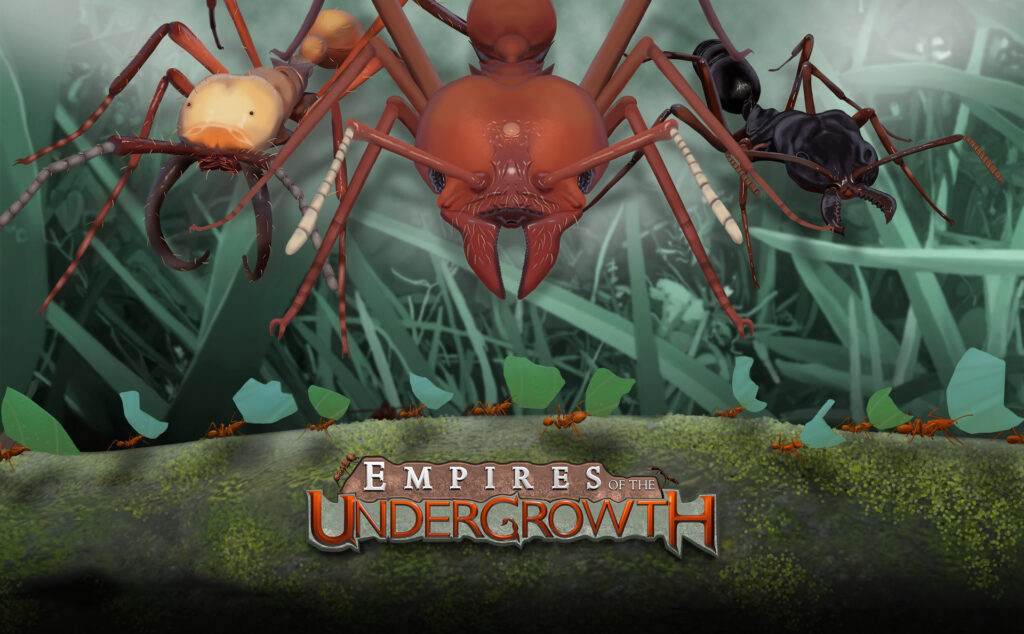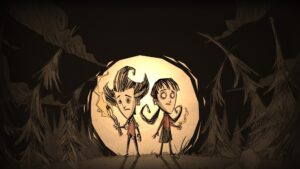
Introduction
This guide will be improved upon as the species of the games are introduced or updated or even become playable.
It will talk about all of the species from the starting ants to the most recently added ones.
We will first talk about the first Ants we are introduced to, the player’s Formica Ereptor Ants, or the Gene Stealer Ants.
Formica Ereptor – Gene Thieves (Player Ant)
Formica Ereptor, the Gene Thief Ant Species, not a real ant species and only exists in the game, is the player’s controlled ant species. The Queen of the Species at first starts out rather pathetic compared to what its name suggests, only capable of producing a single type of ant at first, the worker.
However, this is only at first, as every ant colony starts out similarly to what the player starts with, a single queen and a few workers.
Where Ereptor’s strengths come into play is the fact that, unlike the other species of ants, Formica Ereptor can use the genetic strains of ‘other’ species, and build their ants as if they were one and the same species.
This makes Ereptor the ultimate ant species, as the others cannot do this and are stuck with their own species which will be discussed in their own separate sections of the guide.
Formica Ereptor Queen
Formica Ereptor’s queen is like all other Queens, a giant ant that sits in the center of your colony and does nothing by herself.
She cannot attack, she cannot defend herself, but unlike all the other ant queens, she possesses unique abilities, and can activate two of four powers when her health drops below 75%.
She can summon the Royal Guard, a squad of 6-7 giant Ereptor ants that have high health and strong attacks around her that will attack and defend the queen from attackers to the death, for a set period of time.
She can unleash a hoard of ants for free for a set period of time, allowing nursery tiles to be refilled with eggs even if empty and hatch their ants without needing to pay for them instantly.
She can stun enemies around her and in the whole nest for a period of time.
Or she can restore her health and fully plant and release a new group of ants from their nursery tiles for free.
Formica Ereptor Worker
The first and only ant available to Ereptor at the start, the Ereptor worker fulfills two jobs crucial to the colony’s survival and thriving.
While any ant can collect food, only the workers can either dig tunnels or chambers, plant down nursery tiles, plant down food storage tiles, plant down highway tiles, or pick up and plant larvae from the queen and to their assigned nursery tiles.
They are needed and despite their small size, low health, and weak attacks, can defend themselves if their number is high enough. However, workers should only be used for attacking or defending as a last resort, as they much prefer to do their duties as egg carriers to the queen while the soldiers do the real fighting.
All other species of ants that Ereptor can use are covered later on and will have a (Ereptor) word next to the ant type’s name.
Formica Fusca – Black Ant’s Basics
Formica Fusca is the first ant introduced to us in the game, and while Formica Fusca has very little diversity (only two ant types to the colony) it fulfills the purpose in the Ant universe and the game.
Formica Fusca’s Queen is just a giant fat ant that sits there and does nothing, she lays eggs and if she dies the colony dies.
As for the two Ants available to Fusca, they are Worker and Soldier.
Formica Fusca Worker Ant
Formica Fusca’s worker is a basic ant. It performs all the functions of the workers, similar to Ereptor’s worker. It can gather food like other ants, and picks up eggs from the queen, deliver them to nursery tiles that the player builds, and place down food storage and highway tiles.
Unlike Ereptor’s Workers though, Fusca workers tend to be also capable soldiers, as I’ve personally noticed that workers can deal slightly more damage and are best used in large numbers against single enemy targets. Don’t rely on them for warfare, but if necessary they are more than capable of acting as soldiers in large numbers.
Formica Fusca Soldier Ant(Ereptor)
The Fusca Soldier is the workhorse of the Fusca empire. It’s a capable ant with average health and average attack strength. What it has over the worker is that its attack speed is higher, and when upgraded can deal much higher damage and attack faster while also enduring more hits than the worker can ever do.
It costs more food to plant but it pays for itself by being a staple soldier and capable asset to any army.
When controlled by the player in the Ereptor Hierarchy, Fusca Soldiers are the swarming melee soldiers. They are best used as front line combat ants, and meatshields for other weaker ants, or even a screening force for workers going about their business.
When upgraded they can either deal more damage, endure more damage, even recover health while out of combat or retreat from combat when they lose a percentage of their overall health.
Formica Sanguinea – The Slave Maker Ants
Formica Sanguinea is only encountered during the Fusca Level in Challenge 1.2.
Formica Sanguinea are not really ‘dangerous’, per se, in that they don’t have the numbers or strength to overpower the Black Ant soldiers 1 on 1, but they are dangerous to the colony because of their nasty ability and how they attack the colony.
They will attack in waves, charging into the nest in squads of increasing number as the colony progresses in time.
Sanguinea only have ‘1’ ant type that is encountered, a Slave Maker Soldier.
Slave Maker Soldier
Slave Maker Soldiers are after the colony not to exterminate them, but to steal larvae for their own colony. When they attack, half will engage the Colony Ants in battle, acting as a distraction while others rush and dash to the nursery tiles of the colony.
The Soldiers of the Sanguinea are on par with the Black Ant Soldiers in terms of health, damage, and speed. They are best engaged in standard Ant versus Anything tactics, ideally combined with your workers.
If any of the Slave Makers that are going for the larvae manage to grab one and get away, that tile will be put onto a cool down in which no larvae can be placed. If the ant belonging to that tile is killed, it cannot be replaced until the cooldown is over.
As stated before, they do not pose a strong threat, but if Black Ant colony cannot get the numbers needed to push them back without suffering significant losses, the increasing raid strength will soon overwhelm the colony.
They cannot be encountered anywhere else and as such only are unique to level 1.2 of the black ant campaign for now.
Formica Rufa – Wood Ants with Range
Formica Rufa is the ‘2nd’ playable species that can be encountered and played besides Fusca and not counting Ereptor.
Formica Rufa is special in that unlike Fusca, Rufa has more types of ants than just traditional Worker and Soldier. It has 2 types of soldiers that are best employed ‘together’ to form a powerful army.
Formica Rufa Queen
She is like all other Queens, fat, sits there, and lays eggs. If it dies you lose.
Formica Rufa – Worker
Formica Rufa Workers are like all other Workers. They do little damage, they have little health, and perform worker jobs. Unlike Fusca workers though, they do not possess strong attacks and are best employed as gatherers, performing worker jobs underground in the nest. They can be used as early game frontline forces like all other workers though.
Formica Rufa – Melee Soldier
The melee type of the Formica Rufa soldiers have extremely weak attacks. However, they make up for this by having extremely high health. This makes them ideal ants to act as ‘meat shields’, as they can endure a ton of damage compared to the rest of the Rufa force.
In particular they are best employed alongside their ranged counterpart, be it the Motor or Rapid version.
Formica Rufa – Ranged Motor (Ereptor)
Formica Rufa Motor Ants have low health and are more expensive than their melee counterparts, but make up for this by using ‘ranged’ attacks instead of melee combat.
The Motor version has much slower attack speed, but has higher damage
When upgraded, the Motor Ants can deal splash damage as well.
Formica Rufa – Ranged Rapid (Ereptor)
Formica Rufa rapid ants have also low health but have a much more attack speed, even if they have a low damage output.
The Rapid type can be upgraded , giving them a slowing attacking effect.
=Note=
You can only pick ‘1’ of the Rufa ranged ants to use, so when you decide you must choose either Motor or Rapid.
Rapid deals faster damage with weaker individual shots, while the Motor deals slower but ‘stronger’ attacks.
Atta Cephalotes – The Ant Vegans
The newest Playable Ant species, and also the most complicated of them so far. Atta Cephalotes, also known as the Leaf Cutters, act very differently from every other ant species in the game.
As their name suggests, The Leaf Cutters get their food not from other insects, bits of meat from fish or seeds, but from leaves.
This species harvests plants by cutting up and bringing bits and pieces of leaves to its colony and dropping them off. Here they are picked up and taken to nursery tiles to become Fungus, which is what the colony uses for food.
As this species uses leaves as a nutrition source, killing other insects will not offer them food of any kind.
As for the ants themselves in the species, Atta Cephalotes takes ant types to another level and puts all of its Ants into various castes, each with their own roles and purpose in the colony.
Atta Cephalotes Queen
Same as with the other queens, the queen is just fat and lays eggs. If she dies, the game is over.
Atta Cephalotes Minum Workers
The Minums are the lowest caste, as well as being the absolute tiniest ant of any species. These little ants do not leave the nest for any reason, nor can they be commanded at all. They cannot attack, they have little health and perform the most important jobs that the other ants can’t do.
Minums go to leaf storage tiles and collect bits and pieces of leaves, and bring them to various nursery tiles to be cultivated into Fungus, which is used as food.
They also collect the waste product that the fungus produces and drops them off in ‘refuse’ chambers, where it sits and slowly disintegrates.
Minums also are the only ant that are unaffected by the Refuse Chambers negative effect on ants.
Atta Cephalotes Minor Caste
The Minors of the Leaf Cutters fulfill the role of other workers, they harvest, plant nursery tiles, leaf storage tiles, and waste refuse tiles.
This caste of leafcutter can harvest leaves like all leafcutters, but because of their size, they cannot carry heavy loads, and any leaves they carry will slow them down considerably.
They are poor attackers like all workers, but as always can be used effectively in great numbers.
Atta Cephalotes Midae Caste
The Midae caste of the leafcutters are considered a hybrid of soldier and worker. They are the workforce of any Atta Cephalotes harvesting operation, capable of cutting larger chunks compared to their Minor sisters, without being slowed down.
In a pinch, the Midae Caste can easily fight off minor threats and in large enough numbers, can take on larger threats.
What they cannot do though, is take on major threats that are just too powerful to overcome even with numbers. That is where the Leaf Cutter Colony unleashes their final caste.
Atta Cephalotes Major Caste (Ereptor)
The Major Caste of the Leaf Cutters is the ultimate soldier and is the backbone of any army in the Leaf Cutter Arsenal.
They are one of the largest ants in the game. Their powerful size and gigantic jaws make them the ultimate force to be reckoned with on the field.
Even though they are soldiers, the Major Caste can easily use their powerful muscles and slicing jaws to carve up leaves and carry chunks too large for even Midae to carry back to their nest.
When the Ereptor Colony uses them, they can be upgraded to either draw in attacks toward them and away from other weaker ants, or to ‘stun’ enemies smaller than them for a short duration.
Boasting high health and powerful but slow melee damage, they are the first into battle, and are often the last ones to fall.
Odontomachus Bauri – Trappers of the Undergrowth
Formica Odontomachus Bauri, more commonly known as Trap-Jaw Ants, are only seen in the Leaf Cutter missions, in particular, 3.1 while two warring leaf cutters compete.
They typically roam the undergrowth in small groups of two or more, and rarely attack colonies. They will only engage leaf cutter ants if they happen to cross paths.
There is only one type of Trap Jaw ant, which is the Wandering Soldier class.
Odontomachus Bauri Soldier
The soldier of the Trap Jaw ant sports a powerful set of pincers, designed to ensnare and slice their targets.
While they are dangerous against small numbers, against bigger groups of ants, these solo hunters will not fare that well. What makes them unique and dangerous is their uncanny ability to ‘disengage’ from their enemy after taking a bit of damage.
Once their health drops below a certain point, they activate their leap ability, using their pincers to fling themselves away from their target. This allows them to temporarily retreat, but at the same time regenerate some health before they reengage.
As time passes the Trap Jaw hunting parties will grow in number, making them more and more of a threat the longer you deal with them.
Eciton Burchellii – Roaming Ant Horde
Eciton Burchellii are by far among the ‘strongest’ ant species known in the game.
The army ants are encountered only in the 3.2 level of the leaf cutter ants. They have a similar Caste system to the Leaf Cutters, but unlike their vegan cousins, the Army Ant roams the Undergrowth in search of prey.
Wherever they go, the horde as a whole will quickly spread. They will set up their nest and quickly spread out to consume and hunt down whatever they can. Insects will flee from their paths, threats the player may fear will become trivial to them. Their power becomes known in their caste of ants.
Eciton Burchellii Scout Caste
The Scouts of the Army Ants are about the size of Minums for the Leaf Cutter, if not even smaller. They have extremely low health and low attack.
By themselves, they are no threat to even the lowliest caste in the Leaf Cutters, but they possess a unique power that makes them a priority threat to the player’s leaf cutter colony. If they encounter anything living that is a threat, or a potential target, they will retreat and lay down a trail to the location where they encountered the threat, bringing with them a small battalion of Army Ant Soldiers.
Eciton Burchellii Worker Caste
The Burchellii workers, like all workers, pose little offensive threat to their enemies, but in large numbers can become a massive threat. Unfortunately, the numbers are usually massive enough.
They are seen walking along a trail guarded by the Majors of their colony, carrying food back to their nest or scavenging any poor creature foolish enough to wander into their hunting lines.
Eciton Burchellii Major Caste
Though only half the size of the Leaf Cutter Majors with less health compared to the massive warrior of the Vegan Ant colony, Eciton Burchellii Majors are just as recognizable to anyone by their massive heads with powerful pincers.
Eciton Burchellii Majors may have less health compared to their leaf cutter major counterparts, but they compensate for this by having an even ‘stronger’ attack, and a unique ability. During combat, if any Major engages in battle with others around it, after a while or after securing a kill, the Major will release a pheromone that encourages even faster attacks by allied ants around it. This makes the Army Ant Major the greatest threat to any ant colony it comes across.
Unless overwhelmed quickly, a single Major surrounded by dozens of workers can overpower even bigger ant armies.
Player Ant Strategies
When playing as any of the playable ant colonies, you should consider an overall strategy.
We will not cover the Ereptor Ants because that is player choice, and as such, the only thing that stops you from becoming a dominating force is your lack of upgrades and ant species.
Fusca, Rufa, Atta Cephalotes Strategies
Formica Fusca
Formica Fusca, the Black Ants, are the most basic of ant colony species in the Undergrowth, only possessing 2 types of ants (workers, and soldiers).
Their playstyle is just as basic. Simply build up your workers and soldiers, and use the only thing they have to their advantage, their superior numbers.
As they do not need overcomplicated strategies or plans. They simply have to build up a large army and swarm their enemies using superior numbers and overwhelming force.
Formica Rufa
Formica Rufa, or the Wood Ants, can use the same superior numbers playbook as the Black Ants, but combine it with army composition.
While one common plan is to use the cheap workers as simple fodder for your ranged ants, which deal the real damage of the Rufa Colony, they do not have the health needed to endure a sustained attack for long. The only way this works is if you invest ‘heavily’ into workers, and can keep up the sustained losses.
The real meatshields are their melee soldiers that should act as the frontline of your army.
For ranged, Rufa’s motor or rapid fire ants each deliver damage in their own ways, either dealing lots of smaller hits or massive damage in slow volleys. Upgraded they can also deal either slowing venom damage or splash damage.
One way to maximize their damage output is to have just slightly ‘more’ ranged Rufa ants compared to melee Rufa ants. The ideal composition depends on the mission or game type you find yourself in. Generally you want to have enough ranged ants to kill larger prey before it can devour all of your meat shields.
Atta Cephalotes
Atta Cephalotes possess a unique if somewhat ‘slower’ way of producing food.
Their caste system also makes it so, that most of the time there is always someone harvesting leaves. However, the Major’s time should be spent defending and only harvesting if the threat to the leaf cutter line is minimal.
Because of how Expensive Majors are (150 just to ‘plant’ a tile, and 15 to hatch a larvae) they are often not the ant type you should buy too many of.
The Minors being cheapest (20/2) will be doing a lot of the harvesting, alongside their larger cousins the Midae (80/6). Remember that the amount of Minum ants is based on the total amount of brooding tiles you have. So building lots of Minor chambers will give you enough Minums to take care of all the incoming leaves and fungus.
When it comes to warfare, in particular colony versus colony warfare, it’s all hands on deck. Because of how slow it is for fungus to grow and how expensive Majors and Midae are to plant, you will need to use swarming tactics to win. Use every ant in the harvesting line to attack unless your income is high enough to support massive numbers of Midae alongside Majors.
While the others can rely on ‘quantity’ to win most battles, the Leaf Cutters should focus on ‘Quality’, upgrading their majors first and Midae second. As for every Major you lose, it will be another 15 food to hatch another. If the harvesting line is constantly under attack by stray bugs, you’ll be spending 2 for every worker, 5-6 for every Midae, which piles up fast and can deplete your fungus reserves quickly
Formica Sanguinea, Odontomachus Bauri, Eciton Burchellii
As you cannot play as these ant colonies, the only thing you can do is play against them.
Fighting against these 3 ant species has their own challenges.
Formica Sanguinea
The strategy when fighting against this ant species is simply to have higher numbers and use everyone to attack them. While one group holds off their attackers, another one tries to stop those that try raiding the larvae nests.
They aren’t that dangerous when numbers are on your side.
Odontomachus Bauri
Odontomachus Bauri trap-jaw ants are not like the other ant colony enemies. They do not engage in colony warfare at this time in the game. All they do is roam the undergrowth in small groups of Ants.
Their unique method of fighting, attacking, and then leaping away to recover health means that to defeat them you need to consistently engage them. If you can outnumber them while keeping them under constant attack, their ability to regenerate health will be minimal.
Eciton Burchellii
Eciton Burchellii are by far the greatest threat your colony will face. Their numbers, their powerful attack, their hoard mentality, and the fact that if even one scout escapes, it will bring in a battalion of Army Ants, makes them a threat to be respected.
The first thing you need to do is prepare for them. Do not engage the Army Ants until you have a sufficient number of ants. When you do battle them, you have to commit to throwing them back using ‘everything’ you have. Use Leaf Cutter Minors, Midae, and Majors together to fight them as using only the Majors will result in them being overwhelmed by the horde.
Because in 3.2 the horde of Army Ants will continue to assault a path until they’ve taken sufficient losses, you will need to keep the pressure up on them. To that end, numbers alone won’t be enough. You will need quality on your side, and one way to have that is to upgrade your Majors to counter ‘their’ Majors. Remember that Major Ants are the most expensive to rebuild of all the Ants in the Leaf Cutter arsenal, so investing into an upgraded batch of Majors is going to be a better investment than having a ton of Majors that will quickly drain your food reserves in a sustained fight against the Army Ants.
Speaking of Majors, Eciton Burchellii majors are by far the strongest and scariest of all the ants you’ve faced. They improve the attacking power of allies, they hit hard, and they never stop coming.
Their one weakness is low health, so if you can overwhelm them quickly their ability to boost damage will be lost.
When pushing the swarm back, be careful when you engage, as not only Workers but Majors will travel along the path together, so if you are fighting on one side you can find yourself in a pincer between two waves of Army Ants.
Conclusion
And that’s it for now, I’ll update this guide as new ant species are introduced.
Give me your thoughts down below!
And treat your workers right!
Disclaimer: This guide was written by Imperatordavius (with small adjustments by me who graciously allowed me to post this guide here.
Check him out on his channels:
Find the Empires Of The Undergrowth review here.


